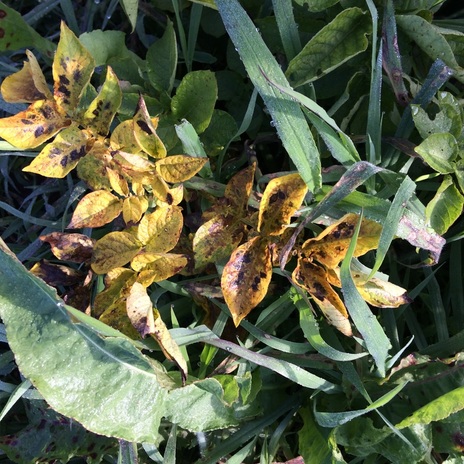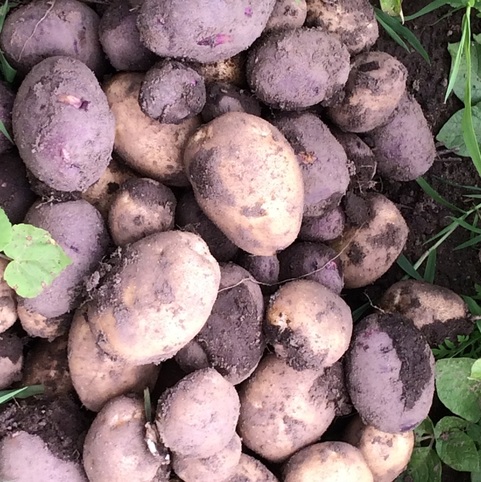This morning we had one of those incredible, serendipitous experiences on the farm that remind us of just how dependent we are on things absolutely beyond our control, and how negatives can so quickly turn to positives in the farming game. Here's how it went down. When I took my morning walk around the fields, I headed first for the potatoes. This plot is at an important stage, since it's the time when Colorado Potato Beetles start doing serious damage on the plants. For weeks, we've been smooshing adult beetles as they show up, but now we are seeing little red grubs here and there. These are the babies from the beetles we missed, and this second generation is the one that can really wipe out the foliage and limit your tuber yield. So I went out with my grub-drowning bucket of soapy water and saw this:
Clearly something was amiss in my potatoes! With our recent pounding from storms, I assumed we'd had a bloom of blight, fungi which love water and wind and moisture and cool nights. I snapped a flurry of pictures and sent them off to Ruth Genger, potato expert at UW Madison. I had the great fortune to have just had Ruth out on my farm last week, since I am participating in some research she is conducting, and she knew what my potatoes had looked like before the storms. Ruth regretfully agreed that the situation appeared to be late blight, a devastating and fast-spreading disease. She said I should probably pull up all the affected foliage, double-bag it and get rid of the bag as soon as possible before the blight spread to the rest of my potatoes and nearby tomatoes. But Ruth said she'd confer shortly with Amanda Gevens, plant pathology expert at the UW Madison, and confirm.
While I waited for her call, I got my thoughts together and decided to dig the affected plants up to see if there were some tiny tubers I could salvage from the rows. I don't typically dig potatoes this early, even for new potatoes, so I had little hope. I rushed back out to the field, digging fork and thick garbage bags in hand. That's when I found this:
While I waited for her call, I got my thoughts together and decided to dig the affected plants up to see if there were some tiny tubers I could salvage from the rows. I don't typically dig potatoes this early, even for new potatoes, so I had little hope. I rushed back out to the field, digging fork and thick garbage bags in hand. That's when I found this:
Gorgeous, un-scabbed and HUGE potatoes. I have bigger potatoes and higher yields RIGHT NOW than I typically see when I dig for mature tubers in late August! I made it through test-digs in all of my varieties right before I got Ruth's phone call telling me that Amanda thought the pictures looked like water damage rather than blight. The news was a relief, since controlling blight is next to impossible even when you pull the plants, since you release millions of spores in the pulling. Relief is really an understatement, though, because the whole experience was a set up for an incredible blessing. Farmer confession time: those potatoes really needed to be weeded. And mulched. I had been quite behind in these tasks. Now, I had carte blanche to dig most of my potatoes in the next week, and save all of the extra labor I would have put into them. And so my CSA members have beautiful potatoes in the same box with fennel this week. This is one of my favorite combos and one I rarely accomplish in the same box, since the fennel is generally bolting by the time the potatoes are ready to dig. Ah, food!
I did double-bag the foliage from the yellowed plants I dug up, though. Just in case! I will be delivering CSA boxes to Madison tomorrow, and on my way in I'll drop some leaf samples at the UW research station for Amanda to examine. We are so very lucky in this area to have access to the top researchers in many agricultural disciplines. Got a garden or plant question? Give them a call yourself! The members of the vegetable team can all be reached via this website: http://vegetables.wisc.edu/.



 RSS Feed
RSS Feed
